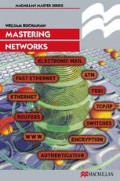Abstract
A token-passing mechanism allows orderly access to a network. Apart from Token Ring the most commonly used token-passing network is the Fibre Distributed Data Interchange (FDDI) standard. This operates at 100 Mbps and, to overcome the problems of line breaks, has two concentric Token Rings, as illustrated in Figure 5.1. Fibre optic cables have a much higher specification than copper cables and allow extremely long connections. The maximum circumference of the ring is 100 km (62 miles), with a maximum 2 km between stations (FDDI nodes are also known as stations). It is thus an excellent mechanism for connecting networks across a city or over a campus. Up to 500 stations can connect to each ring with a maximum of 1000 stations for the complete network. Each station connected to the FDDI highway can be a normal station or a bridge to a conventional local area network, such as Ethernet or Token Ring.
Preview
Unable to display preview. Download preview PDF.
Author information
Authors and Affiliations
Copyright information
© 1999 William Buchanan
About this chapter
Cite this chapter
Buchanan, W.J. (1999). FDDI. In: Mastering Networks. Macmillan Master Series. Palgrave, London. https://doi.org/10.1007/978-1-349-14966-7_5
Download citation
DOI: https://doi.org/10.1007/978-1-349-14966-7_5
Publisher Name: Palgrave, London
Print ISBN: 978-0-333-74804-6
Online ISBN: 978-1-349-14966-7
eBook Packages: Palgrave Business & Management CollectionBusiness and Management (R0)

